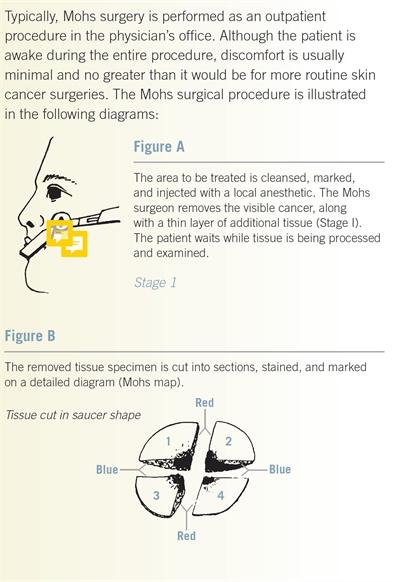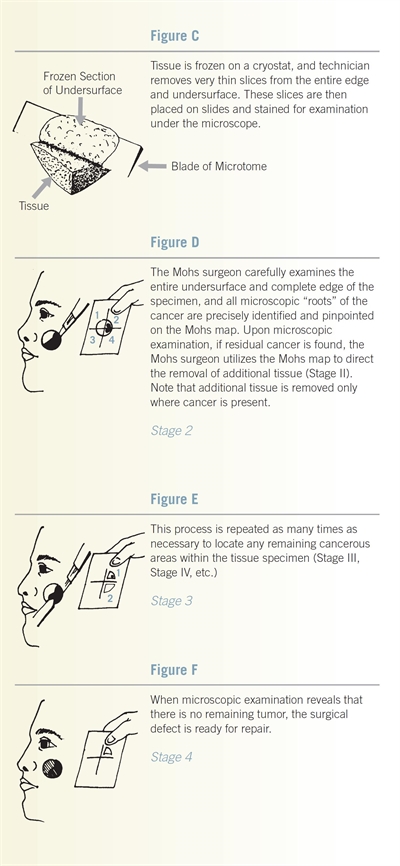What is Mohs Micrographic Surgery?
Mohs micrographic surgery is a specialized, highly effective technique for the removal of skin cancer. The procedure was developed in the 1930s by Dr. Frederic Mohs at the University of Wisconsin and is now practiced throughout the world. Mohs surgery differs from other skin cancer treatments in that it permits the immediate and complete microscopic examination of the removed cancerous tissue, so that all “roots” and extensions of the cancer can be eliminated. Due to the methodical manner in which tissue is removed and examined, Mohs surgery has been recognized as the skin cancer treatment with the highest reported cure rate.Special Qualifications of the Mohs Surgeon
Physicians performing Mohs surgery should have specialized skills in dermatology, dermatologic surgery, dermatopathology, and Mohs surgery. In addition, the Mohs surgeon must have the required surgical and laboratory facilities and must be supported by a well-trained Mohs nursing and histotechnological staff.The Mohs Surgical Procedure


Advantages of the Mohs Surgical Procedure
Some skin cancers can be deceptively large – far more extensive under the skin than they appear to be from the surface. These cancers may have “roots” in the skin, or along blood vessels, nerves, or cartilage. Skin cancers that have recurred following previous treatment may send out extensions deep under the scar tissue that has formed at the site. Mohs surgery is specifically designed to remove these cancers by tracking and removing these cancerous “roots.” For this reason, prior to Mohs surgery it is impossible to predict precisely how much skin will have to be removed. The final surgical defect could be only slightly larger than the initial skin cancer, but occasionally the removal of the deep “roots” of a skin cancer results in a sizeable defect. The patient should bear in mind, however, that Mohs surgery removes only the cancerous tissue, while the normal tissue is spared.Special Indications for Mohs Surgery
It is important to note that Mohs surgery is not appropriate for the treatment of all skin cancers. Mohs micrographic surgery typically is reserved for those skin cancers that have recurred following previous treatment or for cancers that are at high risk for recurrence. Mohs surgery also is indicated for cancers located in areas such as the nose, ears, eyelids, lips, hairline, hands, feet, and genitals, in which maximal reservation of healthy tissue is critical for cosmetic or functional purposes.Duration of Procedure
Most Mohs cases can be completed in three or fewer stages. It is not possible to predict how extensive a cancer will be, as the extent of a skin cancer’s “roots” cannot be estimated in advance.Minor Post-Surgical Discomfort Expected
Most patients do not complain of significant pain. If there is some discomfort, normally only Tylenol is required for relief. However, stronger pain medications are available and may be prescribed when needed. You may experience bruising, swelling and small amounts of bleeding around the wound. If any of these are severe, you should contact your surgeon.Options for Post-Surgical Reconstruction
After the skin cancer has been removed, your Mohs surgeon will consider various repair options. These may include:- Allowing the wound to heal without any additional surgical repair (“healing by secondary intention”).
- Wound repair performed by the Mohs surgeon.
- Repair by another surgeon who might have a particular expertise regarding an anatomic area, repair type, special equipment, or skill regarding repair of inordinately large defects (plastic surgeon or oculoplastic surgeon).
